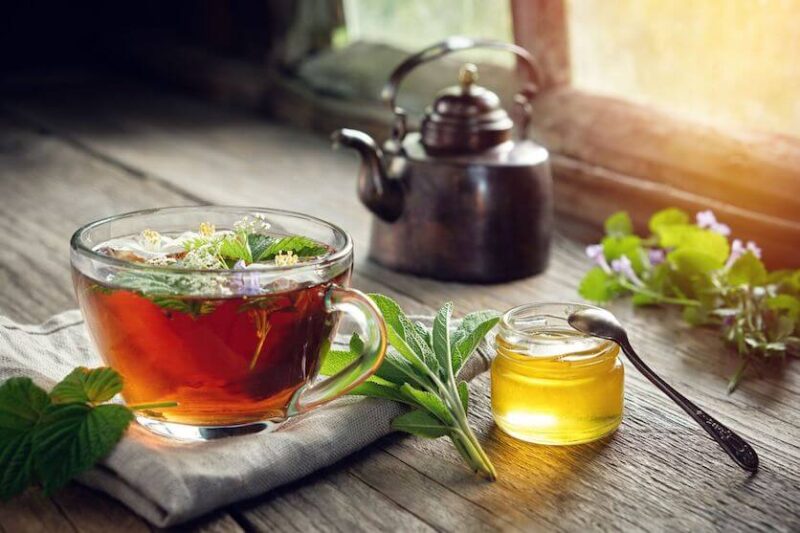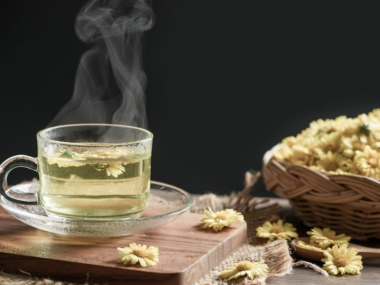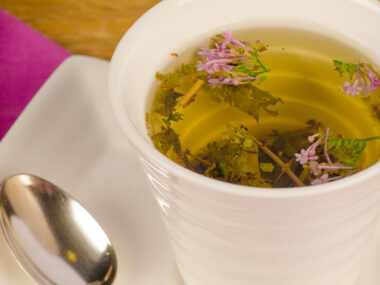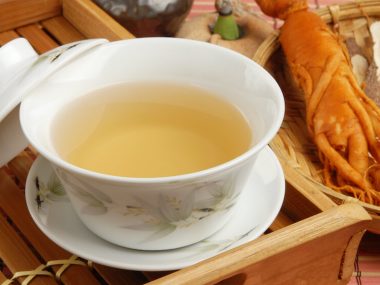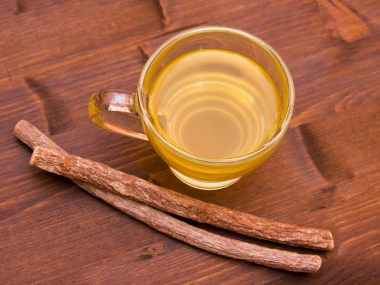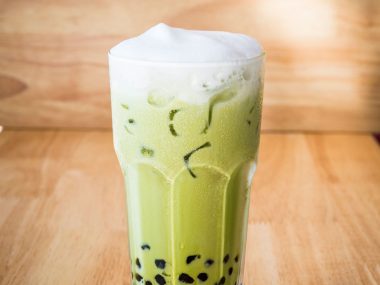There’s nothing quite like the aroma that fills a house on Thanksgiving day as mom prepares the turkey and stuffing. The distinctive flavor that puts the “stuff” in stuffing can also knock the stuffing right out of us if we overindulge. You’ll find this read very informative, and odds are you may learn something you weren’t aware of about sage plant and sage tea!
Table of Contents
What Is Sage Leaf Tea?
Sage tea is a tisane (herbal tea) made from the leaves of Salvia officinalis. This plant is native to countries in the Mediterranean. Though sage herb is grown and used throughout the world in cooking, traditional medicine, and essential oils. For example, essential sage oil is used to help with digestion and is believed to have some therapeutic benefits for the nervous system.
Historical Applications Of Sage
Sage was cultivated not only in the Mediterranean regions but also throughout Europe. During the medieval period, it was grown in northern Europe. From there, it gradually made its way into North America back in the 17th century.
Ancient medicinal treatments with sage were used by Egyptians, Greeks, and Romans. The Egyptians used it to address infertility issues, while the Greeks believed that sage could help stop bleeding and provide relief for sore throat. This traditionally used herb for ailments was eventually adopted by India for Ayurvedic, Siddha, and Unani practice.
Native Americans also had different applications for sage. They performed a ceremonial practice to cleanse a space of bad “ju-ju” by placing a bundle of dried sage into a bowl-like vessel. The sage was burned as an incense. It was believed that the lovely aroma of sage filled the air with life and vigor. This ceremony became known as a “Sacred Smoke Bowl Blessing” (smudging.)
“Smudging” also caught on with New Age groups and holistic practitioners. It’s common now to keep a bundle of sage nearby in homes, businesses, clinics, and more to burn. The smoking sage is carried around into each area of the house to chase out negative energy.
What Does Sage Tea Taste Like?
The aroma and flavor of sage remind many of Thanksgiving because sage is one of the main seasonings for stuffing. If we harness the essence of sage and the familiar aroma (from Thanksgiving) and put it in a cup, this is how this tea tastes.
As you take your first sip of sage tea, your palate is met with numerous dimensions and layers of flavors. You will first savor a peppery pungentness and as the sage washes over the taste buds, a noticeable camphor of eucalyptus presents itself with a finish of lemony mint.
How Much Caffeine Does Sage Tea Contain?
Sage tea doesn’t have caffeine in its unadulterated form because it is a tisane (not a true tea.) If blended with other teas such as black or green, it will inherit the caffeine cont from the used tea variety. Most sage teas sold are in their natural state without anything added. Some countries do add additional herbs to sage tea to enhance the flavor.
How Much Sage Tea Should I Drink?
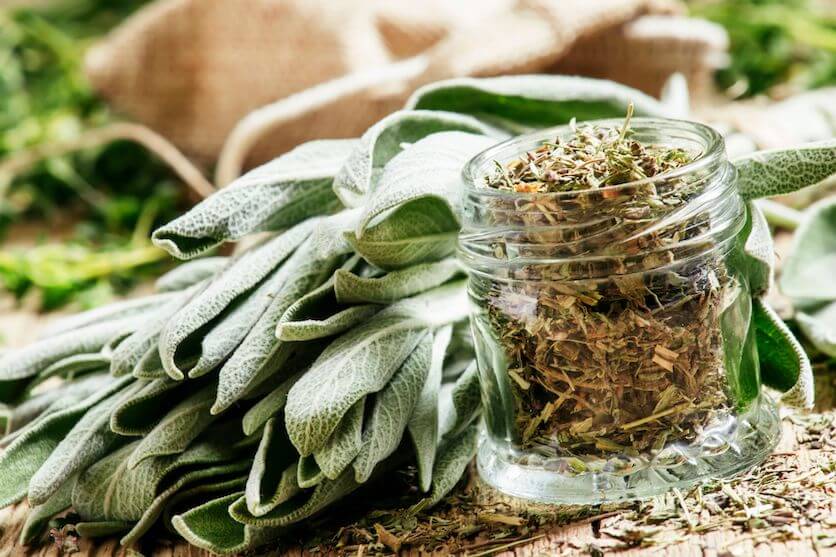
Researchers concluded that about 3-6 cups of sage tea consumed daily are within safe limits. Please note that we cannot recommend what amount is deemed to be safe or dangerous when it comes to drinking sage tea. Do your own research too and consult with a medical practitioner if you have certain pre-existing conditions.
Why Moderation is Required
Sage contains three constituents that can be toxic if consumed in high amounts for prolonged periods. Those three compounds are:
- Thujone
- Camphor
- Terpene Ketones
Salvia officinalis (sage) contains a naturally occurring substance known as thujone. When consumed in high amounts, thujone causes neurotoxicity resulting in convulsions. The oil of sage leaves (essential oil) contains high levels of thujone. Thujone levels vary between sage species, where they are grown, and what age they are. The older the plant, the higher the thujone.
The European Medicines Agency (EMA) purported that thujone levels in a five-ounce cup of sage tea were between 0.7 mg to 5.0 mg. Evidence indicated consuming 3-7 mg of thujone a day to be acceptable “without concern.” They further stated that an intake of thujone should be limited to “a maximum duration of use of 2 weeks.” Because of this, pregnant or nursing mothers are cautioned against consuming sage tea.
So, as a tea drinker, you decide whether or not sage tea if for you.
Sage Tea Benefits
Although there are side effects and adverse reactions that accompany the intake of too much sage, there are also added health benefits. It’s perhaps these benefits that make sage an attractive herb to use for brewing. The essential oil, flavonoids, and terpenoids in sage are beneficial agents that can help fight bacteria, disease, and other medical conditions.
While we are not experts in how sage truly affects or benefits individuals, we can provide you with data from those who are professionals who have scientific data that supports their findings.
Helps With Memory
Sage is reported to help with depression, cerebral ischemia, and other disorders of the memory, such as dementia and Alzheimers. Various sage species have been used in traditional medicine to help restore or improve declining mental function.
Today most healthcare providers prescribe ACE inhibitors to counteract declining mental functioning. These medications prevent the production of a particular enzyme that blocks synapses in our brain. A study found that the essential oil of sage has been found to block 46% of the enzyme.
Additionally, the same group of researchers claims that sage not only improves our mental status and functioning but it promotes a sense of elevated awareness, calm, and attentiveness.
Helps With Menopausal Hot Flashes
Over the centuries, sage has been used in traditional medicine to treat symptoms of menopause. A clinical study on how sage alleviates hot flashes and symptoms associated with menopause revealed sage to be beneficial. A daily intake of sage resulted in the validation for the use of sage in traditional medicine and its effectiveness in helping to alleviate hot flashes and symptoms.
How to Drink Sage Tea
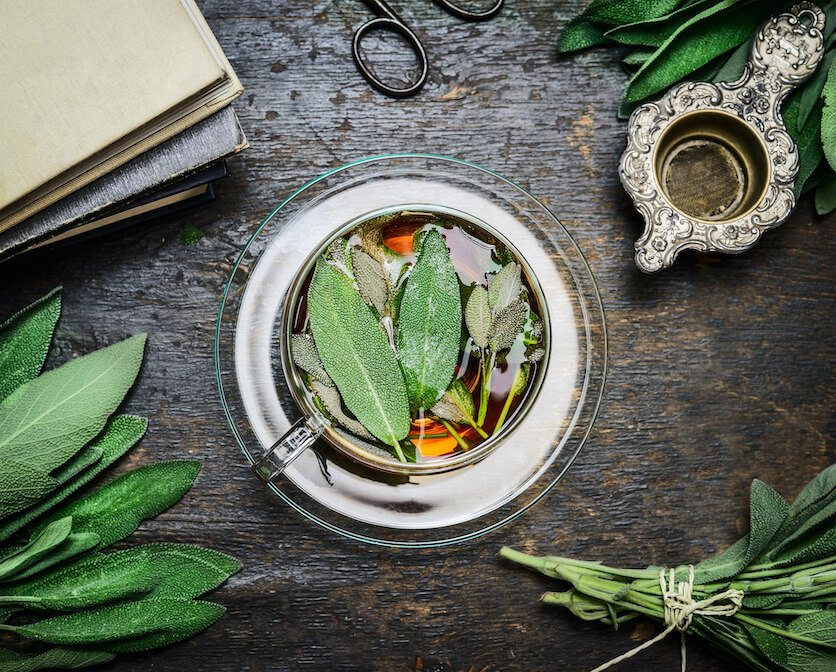
Sage tea is relatively straightforward and easy to make. Knowing how much is too much is the key to staying within the safe recommended limits. We have a few recipes to make sage tea that you’ll enjoy.
Just a word of caution on making sage tea. If by chance, you purchase sage tea rather than pick it fresh from your garden, a sage tea marked “medicinal” may have higher amounts of thujone.
Traditional Sage Tea Recipe
This sage tea recipe is an unadulterated form of this tea. Because it’s pure tisane (herbal), it’s free of caffeine.
Ingredients
- 6 oz. of water
- 1 wedge of lemon
- 2-3 fresh sage leaves
- Honey (optional for sweetening)
Tip: Fresh sage leaves can be found in your grocery store in the produce section where packaged herbs are. If you don’t have access to fresh, you can use a teaspoon of dried or ¼ teaspoon of ground sage.
Directions
- Bring the water to a boil.
- Remove from heat.
- Drop sage leaves into water and allow to steep for 5 minutes.
- Discard the sage leaves.
- Pour water into a teacup, add lemon (and honey if desired.)
- Enjoy!
Mamaria (Middle Eastern Sage Tea Blended With Black Tea)
This recipe includes using black tea blended in, which will result in the tea having caffeine.
Ingredients
- 6 ounces of water
- 1 teaspoon of black loose leaf tea
- 2 fresh sage leaves
- Sugar (for sweetening)
Directions
- Bring the water to a boil.
- Remove from heat.
- Place the loose leaf black tea in an infuser and drop it into water.
- Drop the sage leaves into the water.
- Allow to steep for 5 minutes.
- Remove the sage leaves and tea infuser.
- Pour the tea into a teacup and add the desired amount of sugar.
Moderation Is Key
Sage tea seems to be a tea worth trying, provided it’s enjoyed in moderation. Overindulging may land you in the doctor’s office. Explore layering flavors with tea by adding a tiny bit of sage to a Russian tea, Kyoto-Rice Genmaicha, or Hojicha.
